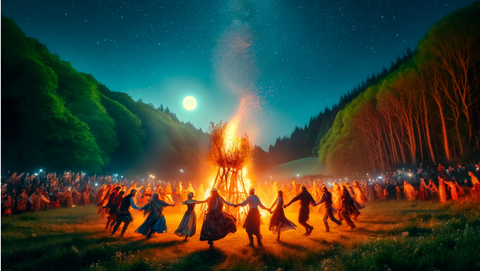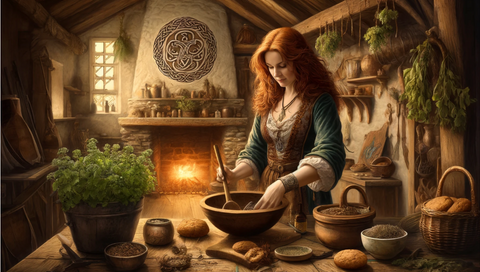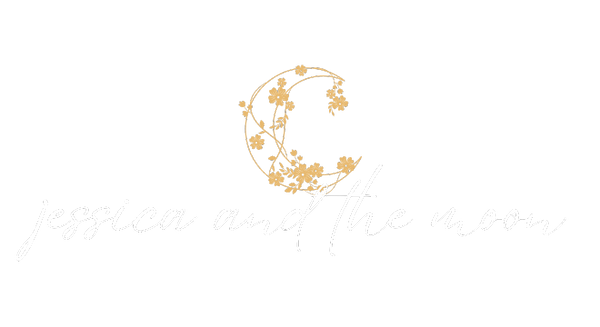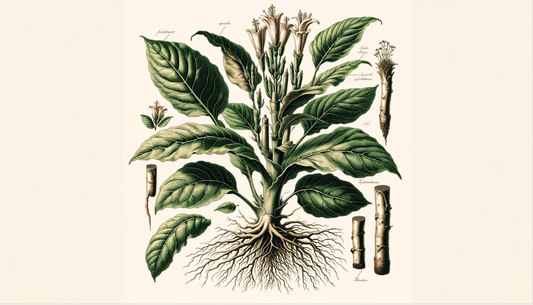Beltane, as celebrated in the modern neopagan community, is a vibrant festival drawing inspiration from the ancient Gaelic festival observed by the Celts in Ireland and Scotland. Yet, as a Welsh witch, I find that my personal observances offer some deviation from tradition, illustrating the diversity of the Celtic spiritual landscape, and the rich tapestry of difference we find from practitioner to practitioner.

Here's a guide to embracing Beltane in your own practice, if that speaks to you, with information about traditional rituals, and ideas for personalising your practice so that it is meaningful and relevant for you, where you live.
When is Beltane?
Traditionally marked on May 1st, the exact timing of Beltane can also align with the blooming of the hawthorn (the "may" tree) or the appearance of other seasonal signs that indicate the beginning of summer. This flexibility in observance speaks to the festival's deep connection to the rhythms of nature.
Themes of Beltane
At its core, Beltane is a celebration of the life and fertility that spring in full swing brings. Historically, in Britain, this was the time when cattle were driven to summer pastures, and people transitioned from the confines of indoor winter life to the expansiveness of summer. Thus, symbolically, Beltane represents thresholds and migrations—concepts mirrored in the purification and protection rituals of the season, such as the lighting of the Bel fires. These fires, through which cattle were driven, were thought to protect from evil spirits and purify the livestock.
The etymology of Beltane could be interpreted as "bright fire" (from the possible meanings of 'bel' as bright, and 'tane' or 'tan' as fire in Welsh), illuminating its themes of light and purification. Traditionally, it was also a time for settling debts and returning borrowed items, preparing oneself spiritually and materially for the season ahead.
Beltane Customs and Symbolism
The rituals and customs of Beltane are steeped in the symbolism of protection, fertility, and communion with nature. Key traditions include:
- Feasting on Seasonal Delicacies: Foods like lamb, bannocks (oat-based bread rolls), oatmeal, and cheese are typical fare, reflecting the agricultural roots of the festival.
- Crafting Rowan Crosses: These are hung in doorways or other potential 'breach points' to ward off unwanted spirits. The use of rowan emphasises its protective qualities.
- Celebrating with Fire and Water: Fire plays a central role in Beltane rituals, symbolising purification. Conversely, water, used for washing the face in morning dew, is believed to confer beauty and protection from the sun.
- Decorating with Yellow Flowers: Flowers like primroses and marsh marigolds are used to adorn spaces, symbolising the vibrancy and renewal of the season.
- Bringing Greenery Indoors: Incorporating branches from trees such as rowan or sycamore into home decor ties the domestic space to the burgeoning life outside.

Cultural Sensitivity and Adaptation of Spiritual Practices
As Beltane originates within specific cultural and environmental contexts, it's important to approach its celebration with an awareness of cultural appropriation. Those with European ancestry in colonised lands should engage with local traditions respectfully and considerately, acknowledging the complex histories of these regions. Some European practices may still be relevant in these places, others may not. Follow what makes sense in a respectful way and all will be well.
For those living in the Southern Hemisphere or in vastly different climates, adapting the celebration to align with local seasonal changes can make the observance more meaningful and relevant.
Beltane in Wicca and Other Traditions
While Wicca—a relatively modern spiritual path—has incorporated Beltane into its Wheel of the Year, it often blends traditional Beltane elements with Anglo-Saxon May Day customs, such as the Maypole. This syncretism reflects Wicca's eclectic approach but also highlights the importance of understanding the origins and meanings of the customs we adopt. This is not to say this is wrong, but it's just something to be aware of when establishing your own meaningful traditions.
For example, as a Welsh practitioner, I celebrate Calan Mai, a festival akin to Beltane but with its unique characteristics and customs, such as Ysbrydnos, the night before May Day, when the veil between worlds is thin, facilitating divination and communication with the otherworld. I resonate with the protective symbolism of Beltane too, so I bring that into my personal practice.
I share more about the history of Beltane and how it has been celebrated, including my personal experiences and practice in this video.
Suggestions for Personalising Beltane Customs and Activities - Using the Elements as Inspiration
Fire Rituals
- Making Blessed Bannocks: These oat-based bread rolls are a staple, symbolising community and nourishment. Each bannock is blessed for health and prosperity. You could use the element of fire to bake something you and your family or friends will enjoy.
- Circling the Fire and Lighting the Hearth Spell: Gather around a fire, moving clockwise, and use the flame to light your home's hearth, carrying the protective energies indoors.
Water Magic
- Collecting Dew for Healing Water/Charms: On Beltane morning, collect dew to use in beauty and healing charms.
- Creating a Magical May Day Facial Spritz: (recipe below)
Earth Magic
- Walking and Blessing Boundaries: Reaffirm your space by walking and blessing the boundaries of your home.
- Leaving Offerings for the Fair Folk: Prevent misfortune by leaving offerings like milk or shiny trinkets.
- Making a May Blessing Bough: Decorate a branch with ribbons to invite protection and joy. This also brings in the air element if it has hanging parts which sway in the breeze.
Magical May Day Facial Spritz Recipe and Rationale
Much is said about the fire element and correspondences of Beltane - it is well known as a time of change and purification, and fertility and sunshine - but, less spoken about in recent years, the water of Beltane is magical too.
It was traditional to visit holy wells on May 1st and the first water drawn from the well conferred special blessings on the person or family who drank it. Families would compete to see who would be the first to draw the water and receive the blessings from the well.
It isn’t just well water which is special. Irish folklore tells that that the dew on Beltane morning is blessed and can ensure clear and beautiful skin for an entire year! Some say it can even prevent sunburn, freckles and wrinkles. But you have to get out there early in the morning. If you leave it too late after sunrise the dew will have evaporated, or, some say, the Fair Folk will have taken it all, for they enjoy its healing and beauty benefits too.
To receive these Beltane water blessings, get up before dawn on May 1st, and before doing anything else, or speaking a single word, go outside to greet the dawn. As the suns rays warm the Earth, touch your hands to the Beltane morning dew and then “wash” (more like pat on) your face with it. As you do this visualise the special dew sinking into your skin, energising and brightening it. If you’re feeling brave (and/or have a private garden) you can roll naked in the dew, to get the benefits over your whole body.
In some traditions the dew collected from specific plants was recommended, like off hawthorn (the May tree) or from underneath an oak.
The dew from the Lady’s Mantle, is told to be especially potent, so if these are available to you then collect the dew from there. With Lady’s Mantle, the shape of the leaves acts like a cup for the dew, so you can carefully collect the dew in a bowl, or use a pipette to draw it up.
NOTE: If you live in a climate where collecting dew is not possible you could use the first skim of water off a clean spring/ stream/ or even out of the tap as an alternative. You can use this water to make the Magical May Day Skin Spritz (method described below) too.

Celebrate the element of water this Beltane by creating a revitalising facial spritz, perfect for daily use.
Ingredients:
- Spray bottle or plant mister
- Muslin cloth or coffee filter
- Clear glass jar
- Funnel
- Optional: a few drops of lavender essential oil
- Spring water
Method:
- Prepare the Water: Fill a clear glass jar with spring water and add essential oil if using.
- Energise: Place the jar in direct sunlight on May Day to charge the water.
- Filter: Pour the charged water through a muslin cloth or coffee filter into another container.
- Bottle: Transfer the filtered water into your spray bottle.
Usage: Spritz on your face after cleansing for a refreshing boost or anytime you need to feel revitalised.
Reflecting on Beltane
Beltane is a time for celebrating life and embracing the change of seasons. Whether through ancient traditions or personal adaptations, this festival offers an opportunity to connect with nature and the energies around us. As you choose activities that resonate with your personal and ancestral connections, "Beltane" becomes a deeply personal celebration that reflects your unique spiritual journey.
For more insights and tips on embracing Welsh folk witchery and astrology visit my website or check out my YouTube channel.
Do you celebrate Beltane? Which practices are meaningful for you at this time? Let me know below.
Wishing you a magical and transformative Beltane!





